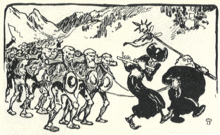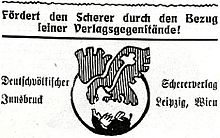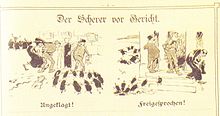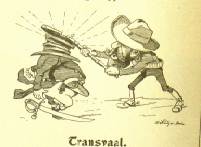The Scherer - the first illustrated Tyrolean joke sheet
Der Scherer - the first illustrated Tiroler Witzblatt (later: Der Scherer - Illustrated Tiroler Halbmontatsblatt für Kunst und Lune in Politics and Life) was a satirical magazine that appeared from 1899 to 1906, first in Innsbruck , then in Linz and finally in Vienna . The editor was Karl Habermann , who also determined the ethnic , national liberal and anti-clerical orientation of the "Scherer".
Foundation and name
The name of the magazine, which among other things took the Munich Simplicissimus by Thomas Theodor Heine as a model, points to the programmatic orientation of the “Scherer”: In Tyrol, the pest fighters, especially small animals , were called “Scherfolk” or “Scherer” (e.g. rats, moles) in favor of better agricultural use. The “pests” that Scherer promised to take care of in the interests of his readers were primarily the Catholic official church and Catholic-conservative politicians, the Austro-Hungarian bureaucracy, and Jews .

In the following poem, the "Scherer people", as the editorial team describes themselves, point out:
" The shearer is under the church ban / that can't shear him / and the angry dark man (= nickname for clergy , note) / will not convert him. / He goes to the field as before / buries his trappings there (= dialect: traps for rats and moles, note) / and he pulls them up again, some shears (= Tyrolean dialect for mole, translated: clerics) are in there fidget . "
The first edition of "Scherer" appeared on May 1, 1899. The verses and caricatures directed against the prevailing conservative mentality in Tyrol secured the sympathy of a large part of the liberal-bourgeois intelligentsia for the "Scherer". In particular, the magazine became a meeting point for the Jung-Tirol literary movement .
The writers and poets Arthur von Wallpach , Anton Renk , Hermann Greinz , Heinrich von Schullern and Carl Dallago as well as the painters and draftsmen Arpad Schmidhammer , Eduard Thöny and Ferdinand Freiherr von Rezniček appeared as employees in the first few years .
The völkisch - Pan-German propagandist Wilhelm Rohmeder launched calls for boycotts against non-German “restaurants in the linguistic border areas, which are recommended to German travelers” in “Scherer” before 1903 and combined this with anti-Italian agitation.
Development of the Scherer until 1904
In the first phase up to 1904, the “Scherer” had become an enemy of the Catholic-conservative Tyrol due to his biting satire and uncompromisingly German-national- liberal rhetoric. Issues were regularly confiscated or censored, and publisher Habermann was repeatedly cited in court because of the anti-clerical caricatures and comments.
As early as July 1899, only three months after the appearance of the first edition, the Brixen Prince-Bishop Simon Aichner warned in a pastoral letter of the anti-religious tendency of the magazine and forbade Catholic believers to read the “Scherer” by stating “ that everyone who reads this paper reads, pays or, as always, supported, badly violated his duty of conscience. "
In the first years of the “Scherer”, in addition to the Catholic official church, especially the Jesuits , the Austrian bureaucracy in particular was an enemy. Until 1902, the anti-Semitism , which is increasingly to be found in German national circles, does not come to light either in the pictures or in the text contributions.
This reluctance towards the Jewish community could be related to the almost religious admiration for the Tyrolean poet Adolf Pichler , who was considered a great role model for the “Scherer people” and who, as a convinced German national, rejected anti-Semitism (quote from Pichler: “I respect them (the Jews , Note) as fellow human beings and advocate that the law of philanthropy also applies to them without restriction. " )
Also, blind nationalism was not to be found in the “Scherer” of the early phase. The Germanness of the Tyroleans was emphasized, but the "Scherer people" were conciliatory towards other peoples.
In particular, the sympathies were with anti-clerical-liberal France; the “Scherer”, contrary to the zeitgeist, advocated Franco-German reconciliation .
Excepted from this approach was Great Britain , which, as an imperialist power , was the target of angry comments and vicious caricatures in "Scherer", mainly because of the cruel warfare against the Boer republics of Orange and Transvaal .
The negative attitude towards imperialist aspirations was a hallmark of the "Scherer". The China policy of the Wilhelmine German Empire was harshly criticized and rejected, with all emphasis on an all-German national consciousness.

In addition to the magazine, the works of the employees were published by the "Scherer-Verlag" of the same name (logo see image on the right). Anton Renk, Arthur von Wallpach, but also Adolf Pichler published their works in Scherer-Verlag. In addition, the Scherer-Verlag mainly also printed postcards, which mostly had political and ideological subjects according to the ideology of the “Scherer”.
The support from the liberal-bourgeois environment and the intellectual scene at the turn of the century is evident from the numerous well-known expressions of sympathy that were published in "Scherer" under the heading "Mailbox": Peter Rosegger , Felix Dahn , Ludwig Thoma , Cosima Wagner and of course Adolf Pichler .
In Austria-Hungary and occasionally in the German Empire, circles of sympathizers called "Scherergemeinden" formed.
In 1903 the "Scherer-Verlag" was taken over by the Upper Austrian Book Printing and Publishing Company and appeared on October 1, 1903 in Linz.
Individual evidence
- ↑ Hoiß / Unterweger: Ein Lokalaugenschein in Tirol 1900–1950 , in: Neuhaus / Holzner: Literatur als Skandal , Göttingen 2007, p. 313
- ^ Andrè Banuls: Das völkische Blatt "Der Scherer" , in: Vierteljahrshefte für Zeitgeschichte 2/1970, p. 199 ( PDF )
- ↑ Der Scherer, edition of the 1st harvest moon 1899, p. 12
- ^ Hoiß / Unterweger: Lokalaugenschein , p. 314
- ↑ Banuls: Scherer , p. 201.
- ^ Michael Wedekind: Tourism and Nation. On the politicization of travel in the late Habsburg Monarchy . In: Hannes Obermair u. a. (Ed.): Regional civil society in motion. Festschrift for Hans Heiss (= Cittadini innanzi tutto ). Folio Verlag, Vienna-Bozen 2012, ISBN 978-3-85256-618-4 , p. 68–93, here: p. 74 f .
- ↑ Innsbrucker Nachrichten, July 4, 1899, p. 1
- ↑ Adolf Pichler: From diaries 1850–1899 , p. 323
- ↑ Banuls: Scherer , p. 200
- ↑ Der Scherer, edition of 17th Nebelmond 1901, p. 14
- ↑ Der Scherer, edition of 1. Hornung 1900, "Buren number"
- ↑ e.g. Der Scherer, edition of 15. Gilbhard 1900, p. 16
- ↑ Banuls: Scherer , p. 201
- ↑ Banuls: Scherer , p. 198
Web links
- Digitized at Austrian Literature Online


